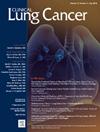在磁共振成像时代,对早中期小细胞肺癌患者进行预防性颅内照射的疗效。
IF 3.3
3区 医学
Q2 ONCOLOGY
引用次数: 0
摘要
背景:磁共振成像(MRI)分期技术的最新进展凸显了在治疗早中期小细胞肺癌(SCLC)时是否需要进行预防性头颅照射(PCI)这一关键问题。本研究评估了PCI对I-IIB期SCLC患者总生存期(OS)和颅内控制的影响:方法:研究了在两个中心接受胸部放射治疗(TRT)的 148 例 I-IIB 期 SCLC 患者的数据。根据 PCI 的使用情况对患者进行分类:63例接受了PCI治疗,85例未接受PCI治疗。所有患者都接受了治疗前磁共振成像,至少对治疗有部分反应。1:1倾向得分匹配分析纠正了潜在的偏差:考虑到患者的人口统计学特征、疾病进展和治疗方法,为116名患者生成了倾向评分。死亡被列为竞争风险。未接受PCI治疗的患者3年脑转移(BM)发生率(30.0%)明显高于接受PCI治疗的患者(14.8%),但差异无统计学意义(未PCI vs. PCI,危险比[HR]:2.08,95% CI [0.93-4.55],P = .07)。PCI对OS无明显影响[PCI vs. No PCI,HR:0.80,95% CI (0.45-1.43),P = .45]。对IIB期患者进行的亚组分析显示,未接受PCI治疗的患者BM风险和死亡率显著增加(未PCI vs. PCI,BM风险HR:5.85,95% CI:1.83-18.87,P = .003;死亡率HR:2.78,95% CI:1.14-6.67,P = .02),而对I-IIA期患者的影响则不太明显:结论:通过现代磁共振成像筛查,PCI 可使 IIB 期 SCLC 患者显著获益,在初始敏感治疗后减少 BM 并改善 OS。这种益处似乎不会扩展到I-IIA期患者。本文章由计算机程序翻译,如有差异,请以英文原文为准。
Efficacy of Prophylactic Cranial Irradiation in Early to Mid-stage Small Cell Lung Cancer Patients in the Era of Magnetic Resonance Imaging
Background
Recent advancements in magnetic resonance imaging (MRI) for staging have highlighted the critical question of the need for prophylactic cranial irradiation (PCI) in managing early to mid-stage small cell lung cancer (SCLC). This study assesses the impact of PCI on overall survival (OS) and intracranial control among patients with stage I-IIB SCLC.
Methods
Data from 148 stage I-IIB SCLC patients treated with thoracic radiation therapy (TRT) at two centers were examined. Patients were categorized based on PCI administration: 63 received PCI, while 85 did not. All underwent pretreatment MRI, achieving at least a partial response to therapy. A 1:1 propensity score matching analysis corrected for potential biases.
Results
Propensity scores were generated to 116 patients, considering patient demographics, disease progression, and treatment methods. Death was included as a competing risk. The 3-year brain metastases (BM) occurrence rate was significantly higher in patients who did not receive PCI (30.0%) compared to those who did (14.8%), however, the difference was not statistically significant (No PCI vs. PCI, hazard ratio [HR]: 2.08, 95% CI [0.93-4.55], P = .07). No significant effect of PCI on OS was observed [PCI vs. No PCI, HR: 0.80, 95% CI (0.45-1.43), P = .45]. A subgroup analysis of stage IIB patients showed a significant increase in BM risk and mortality for those not receiving PCI (No PCI vs. PCI, BM risk HR: 5.85, 95% CI: 1.83-18.87, P = .003; mortality HR: 2.78, 95% CI: 1.14-6.67, P = .02), with less pronounced effects in stages I-IIA.
Conclusion
With modern MRI-based screening, PCI may markedly benefit stage IIB SCLC patients by reducing BM and improving OS after initial sensitive treatment. This benefit does not appear to extend to stage I-IIA patients.
求助全文
通过发布文献求助,成功后即可免费获取论文全文。
去求助
来源期刊

Clinical lung cancer
医学-肿瘤学
CiteScore
7.00
自引率
2.80%
发文量
159
审稿时长
24 days
期刊介绍:
Clinical Lung Cancer is a peer-reviewed bimonthly journal that publishes original articles describing various aspects of clinical and translational research of lung cancer. Clinical Lung Cancer is devoted to articles on detection, diagnosis, prevention, and treatment of lung cancer. The main emphasis is on recent scientific developments in all areas related to lung cancer. Specific areas of interest include clinical research and mechanistic approaches; drug sensitivity and resistance; gene and antisense therapy; pathology, markers, and prognostic indicators; chemoprevention strategies; multimodality therapy; and integration of various approaches.
 求助内容:
求助内容: 应助结果提醒方式:
应助结果提醒方式:


